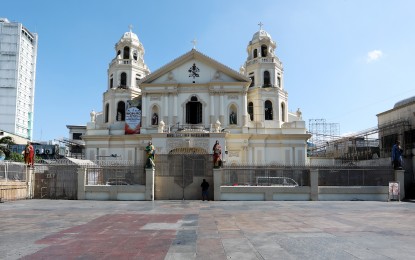
HIGHLY RESTRICTED. Photo shows the Minor Basilica of the Black Nazarene also known as Quiapo Church in Manila. Religious gatherings in areas under modified enhanced community quarantine may now resume but they would be highly restricted and limited to no more than five persons. This is according to guidelines issued by the Inter-Agency Task Force for the Management of Emerging Infectious Diseases on Friday (May 15, 2020). (File photo)
MANILA – The Inter-Agency Task Force for the Management of Emerging Infectious Diseases (IATF-EID) has allowed the conduct of religious gatherings in areas placed under modified enhanced community quarantine (MECQ) and general community quarantine (GCQ).
Cebu and Mandaue cities will be placed under ECQ, while Metro Manila, Laguna, Bataan, Bulacan, Nueva, Ecija, Pampanga, Zambales, and Angeles City will be under MECQ from May 16 to 31.
Other places nationwide that are not under ECQ or MECQ will be under GCQ.
Under the omnibus guidelines on the implementation of community quarantine in the country released on Friday, the last day before the transition, religious gatherings in areas under MECQ would be highly restricted and limited to not more than five persons.
While religious activities are not encouraged in areas placed under GCQ, the IATF-EID authorized such activities, so long as the maximum number of participants is 10.
People engaged in religious activities must observe minimum health standards.
Public gatherings that are “unauthorized, non-work essential, or are entertainment-related” remain prohibited in places where MECQ and GCQ are implemented.
In areas under enhanced community quarantine (ECQ), mass gatherings are still prohibited.
Mall operations
Limited operations in malls and shopping areas in places under MECQ and GCQ will be allowed, except for leisure establishments and services.
Pregnant women and individuals with health risks may not enter malls and shopping centers in areas under MECQ, “except when indispensable under the circumstances for obtaining essential goods and services or for work in establishments located therein.”
For areas under GCQ, individuals aged 21 years and below and 60 years and above may not enter malls and shopping centers, “except when indispensable under the circumstances for obtaining essential goods and services or for work in establishments located therein.”
Leisure activities not allowed in areas under MECQ
The new guidelines also prohibited the public in areas under MECQ from visiting tourist spots, such as water parks and other places that offer similar services.
Operations of entertainment industries, such as cinemas, theaters, and karaoke bars are also banned.
People are likewise not allowed to go to kid amusement establishments; libraries, archives, museums, and cultural centers; and gyms, fitness studios, and sports facilities.
They also cannot avail of personal care services from massage parlors, sauna, facial care, and waxing.
Public transportation
Mass public transportation in places where ECQ and MECQ are imposed remains suspended.
However, commissioned shuttle services for employees of permitted establishments, and point-to-point transport services for front-line workers are allowed to operate at reduced vehicle capacity to observe minimum health standards.
The IATF-EID also allowed exempted individuals to use private company shuttles and personal vehicles, as well as bikes and other non-motorized vehicles in areas under MECQ.
Meanwhile, the road, rail, maritime, and aviation sectors of public transportation in areas under GCQ are allowed to operate at a reduced operational and vehicle capacity.
A strict one-meter distance between passengers must be observed and appropriate engineering controls must be in place, according to the guidelines. (PNA)
